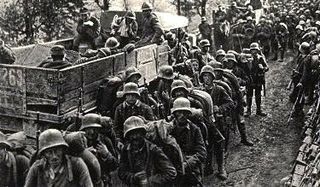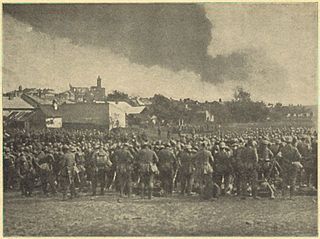The 7th Division was a unit of the Prussian/German Army. It was formed in Magdeburg in November 1816 as a brigade and became a division on September 5, 1818. The division was subordinated in peacetime to the IV Army Corps. The division was disbanded in 1919 during the demobilization of the German Army after World War I. The division was recruited primarily in the Province of Saxony, also known as Prussian Saxony.
The 11th Division was a unit of the Prussian/German Army. It was formed in Breslau in November 1816 as a brigade, and became the 11th Division on September 5, 1818. The division was subordinated in peacetime to the VI Army Corps. The division was disbanded in 1919 during the demobilization of the German Army after World War I. The division was recruited primarily in the Province of Silesia, mainly in the region of Lower Silesia.

The 12th Division was a unit of the Prussian/German Army. It was formed in Neiße on September 5, 1818. The division was subordinated in peacetime to the VI Army Corps. The division was disbanded in 1919 during the demobilization of the German Army after World War I. The division was recruited primarily in the Province of Silesia, mainly in the region of Upper Silesia.
The 30th Division was a unit of the Prussian/German Army. It was formed on April 1, 1887, as the 33rd Division and became the 30th Division on April 1, 1890, and was headquartered in Straßburg. The division was subordinated in peacetime to the XV Army Corps. The division was disbanded in 1919 during the demobilization of the German Army after World War I. The division was recruited primarily in the Rhineland and Westphalia, with the 105th Infantry Regiment recruited in the Kingdom of Saxony.
The 32nd Division, formally the 3rd Division No. 32 was a unit of the Saxon Army, a component of the Imperial German Army. The division was formed on April 1, 1887, and was headquartered in Bautzen. The division was subordinated in peacetime to the XII Army Corps. The division was disbanded in 1919 during the demobilization of the German Army after World War I. The division was recruited in the eastern part of the Kingdom of Saxony.
The 35th Division was a unit of the Prussian/German Army. It was formed on April 1, 1890, and was headquartered initially in Graudenz and from 1912 in Thorn. The division was subordinated in peacetime to the XVII Army Corps. The division was disbanded in 1919 during the demobilization of the German Army after World War I. The division was recruited primarily in the southern part of West Prussia, and included a relatively high percentage of Poles.
The 36th Division was a unit of the Prussian/German Army. It was formed on April 1, 1890, and was headquartered in Danzig. The division was subordinated in peacetime to the XVII Army Corps. The division was disbanded in 1919 during the demobilization of the German Army after World War I. The division was recruited primarily in West Prussia.
The 5th Reserve Division was a unit of the German Army, in World War I. The division was formed on mobilization of the German Army in August 1914. The division was disbanded in 1919 during the demobilization of the German Army after World War I. The division was a reserve division of the III Reserve Corps and was raised in the Prussian Province of Brandenburg.
The 6th Reserve Division was a unit of the German Army, in World War I. The division was formed on mobilization of the German Army in August 1914. The division was disbanded in September 1918. The division was a reserve division of the III Reserve Corps and was raised primarily in the Prussian Province of Brandenburg.
The 22nd Reserve Division was a unit of the German Army in World War I. The division was formed on the mobilization of the German Army in August 1914. The division was disbanded during the demobilization of the German Army after World War I.
The 9th Reserve Division was a unit of the Imperial German Army, in World War I. The division was formed on the mobilization of the German Army in August 1914. The division was disbanded during the demobilization of the German Army after World War I. The division was a reserve division of the V Reserve Corps and was raised primarily in the Province of Posen and the Province of West Prussia.
The 36th Reserve Division was a unit of the Imperial German Army, in World War I. The division was formed on the mobilization of the German Army in August 1914 and was disbanded during the demobilization of the German Army after World War I. The division was a reserve division of the I Reserve Corps and was raised primarily in Pomerania Province and West Prussia Province.
The 33rd Reserve Division was a unit of the Imperial German Army, in World War I. The division was formed on the mobilization of the German Army in August 1914. The division was disbanded in August 1918. The division began the war as part of the central reserve of Fortress Metz.
12th Reserve Division was a unit of the Imperial German Army in World War I. The division was formed on mobilization of the German Army in August 1914 as part of VI Reserve Corps. The division was disbanded in 1919 during the demobilization of the German Army after World War I. The division was recruited in the Province of Silesia, mainly Upper Silesia.
The 13th Reserve Division was a unit of the Imperial German Army in World War I. The division was formed on the mobilization of the German Army in August 1914. The division was disbanded in 1919, during the demobilization of the German Army after World War I. The division was a reserve division of the VII Reserve Corps and was recruited primarily in the Province of Westphalia.
The 14th Reserve Division was a unit of the Imperial German Army in World War I. The division was formed on the mobilization of the German Army in August 1914. The division was disbanded in 1919, during the demobilization of the German Army after World War I. The division was a reserve division of the VII Reserve Corps and was recruited primarily in the Province of Westphalia and the Rhine Province. The division included an active infantry brigade from the 14th Division.
The 17th Reserve Division was a unit of the Imperial German Army in World War I. The division was formed on the mobilization of the German Army in August 1914. The division was disbanded in 1919 during the demobilization of the German Army after World War I. At the beginning of the war, it formed the IX Reserve Corps with the 18th Reserve Division.
The 117th Infantry Division was a formation of the Imperial German Army in World War I. The division was formed on April 2, 1915, and organized over the next several weeks. It was part of a wave of new infantry divisions formed in the spring of 1915. The division was disbanded in 1919, during the demobilization of the German Army after World War I.

The 3rd Landwehr Division was an infantry division of the Imperial German Army during World War I. It was formed on the mobilization of the German Army in August 1914 under the "Higher Landwehr Commander 3". The Landwehr was the third category of the German Army, after the regular Army and the reserves. Thus Landwehr divisions were made up of older soldiers who had passed from the reserves, and were intended primarily for occupation and security duties rather than heavy combat. While the division was a Landwehr formation, at the beginning of the war it also had an attached Ersatz infantry brigade, made up of cadres from various regimental replacement battalions. The division was primarily raised in the Prussian provinces of Posen, Lower Silesia, and West Prussia. The division was disbanded in 1919 during the demobilization of the German Army after World War I.

The 4th Landwehr Division was an infantry division of the Imperial German Army during World War I. It was formed on mobilization of the German Army in August 1914 under the "Higher Landwehr Commander 4". The Landwehr was the third category of the German Army, after the regular Army and the reserves. Thus Landwehr divisions were made up of older soldiers who had passed from the reserves, and were intended primarily for occupation and security duties rather than heavy combat. The division was primarily raised in the Prussian provinces of Upper and Lower Silesia. It was disbanded in 1919 during the demobilization of the German Army after World War I.

